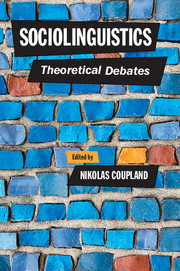Book contents
- Frontmatter
- Contents
- List of contributors
- Preface and acknowledgements
- 1 Introduction: Sociolinguistic theory and the practice of sociolinguistics
- Part I Theorising social meaning
- Part II Language, markets and materiality
- Part III Sociolinguistics, place and mobility
- Part IV Power, mediation and critical sociolinguistics
- Part V Sociolinguistics, contexts and impact
- Part VI The evolution of sociolinguistic theory
- 18 Succeeding waves: Seeking sociolinguistic theory for the twenty-first century
- 19 Language theory in contemporary sociolinguistics: Beyond Dell Hymes?
- 20 Five Ms for sociolinguistic change
- Index
- References
18 - Succeeding waves: Seeking sociolinguistic theory for the twenty-first century
from Part VI - The evolution of sociolinguistic theory
Published online by Cambridge University Press: 05 June 2016
- Frontmatter
- Contents
- List of contributors
- Preface and acknowledgements
- 1 Introduction: Sociolinguistic theory and the practice of sociolinguistics
- Part I Theorising social meaning
- Part II Language, markets and materiality
- Part III Sociolinguistics, place and mobility
- Part IV Power, mediation and critical sociolinguistics
- Part V Sociolinguistics, contexts and impact
- Part VI The evolution of sociolinguistic theory
- 18 Succeeding waves: Seeking sociolinguistic theory for the twenty-first century
- 19 Language theory in contemporary sociolinguistics: Beyond Dell Hymes?
- 20 Five Ms for sociolinguistic change
- Index
- References
Summary
This chapter examines developments in sociolinguistic theory since the 1990s, mainly as they can be traced in the pages of the Journal of Sociolinguistics. First published in 1997, the Journal set itself a theorizing remit from the start, and it has remained committed to that intention. From my perspective as founding co-editor with Nikolas Coupland – and sole editor since 2008, with a team of associate editors – I here review trends in the contents of the Journal, put forward some editorial-insider perspectives derived from reading (to date) more than 2500 submissions across nearly twenty years, and look forward to the future of sociolinguistics.
Three sociolinguistics
Dell Hymes was sociolinguistics’ founding theorist, and any consideration of trends in the field tends to find its way back to his early writings as a means of clarifying where we have come from. In a programmatic essay published more than forty years ago, Hymes distinguished three ways in which (socio)linguistics may view the relationship between the social and the linguistic (1974: 195):
(1) the social as well as the linguistic: addressing social issues which have a language component
(2) socially realistic linguistics: basing linguistic investigation on real-society data
(3) socially constituted linguistics: affirming that language is inherently social and society is inherently linguistic.
The development of sociolinguistics across its more than half a century of history could be seen broadly as a movement from (1) and (2) towards (3), a socially constituted discipline. The way in which language constitutes the social, and the social constitutes language, is now taken as a given in much sociolinguistic work.
The first approach above remains a strong driver in our field – addressing social issues which have a language component. This has always been a goal for sociolinguists of all kinds: to apply their knowledge for the benefit of those they are researching. Often such social intervention has itself been an impetus for conducting the research. Engaged, interventionist research in language maintenance, policy and planning, education, literacy, and other areas (cf. Part 5 of this volume, Chapters 15–17) are staples of sociolinguistic work now, as they were in the 1990s and 1960s.
- Type
- Chapter
- Information
- SociolinguisticsTheoretical Debates, pp. 391 - 416Publisher: Cambridge University PressPrint publication year: 2016
References
- 23
- Cited by

